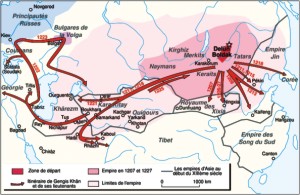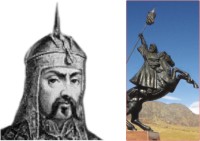Quiz Answer : Genghis Khan
 Genghis Khan (1162-1227), born Temujin was the founder, Khan (ruler) and posthumously declared Khagan (emperor) of the Mongol Empire, the largest contiguous empire in history. Genghis Khan (1162-1227), born Temujin was the founder, Khan (ruler) and posthumously declared Khagan (emperor) of the Mongol Empire, the largest contiguous empire in history.
He came to power by uniting many of the nomadic tribes of northeast Asia. After founding the Mongol Empire and being proclaimed "Genghis Khan", he pursued an aggressive foreign policy by starting the Mongol invasions of East and Central Asia. During his life, the Mongol Empire eventually occupied most of Asia.
Genghis Khan died in 1227 after defeating the Tanguts. He was buried in an unmarked grave somewhere in his native Mongolia. His descendants went on to stretch the Mongol Empire across most of Eurasia, conquering all of modern-day China, as well as substantial portions of modern Russia, southern Asia, Eastern Europe and the Middle East.
Temüjin was born around 1162 in a Mongol tribe near Burkhan Khaldun mountain and the Onon and Kherlen rivers, not far from the current capital of Mongolia, Ulaanbaatar. The Secret History of the Mongols purports that Temüjin was born with a blood clot grasped in his fist, an indication in the traditional Mongolian folklore that he was destined to become a great leader. He was the third-eldest son of his father Yesükhei, a minor tribal chief of the Kiyad and a vassal of Ong Khan of the Kerait tribe, and the eldest son of his mother Hoelun.
Like other tribes, Khan's tribes were nomads. Because his father was a chieftain, as were his predecessors, Temüjin was of a noble background. This relatively higher social standing made it easier to solicit help from and eventually consolidate the other Mongol tribes. No accurate portraits of Genghis exist today, and any surviving depictions are considered to be artistic interpretations. Persian historian Rashid al-Din recorded in his "Chronicles" that the legendary "glittering" ancestor of Genghis was tall, long-bearded, red-haired, and green-eyed.
Like many of the nomads of Mongolia, Temüjin's early life was difficult. At nine years old, as part of the marriage arrangement, he was delivered by his father to the family of his future wife Börte, who were members of the Onggirat tribe. He was to live there in service to Deisechen, the head of the household, until he reached the marriageable age of 12. At this time, none of the tribal confederations of Mongolia were united politically, and arranged marriages were often used to solidify temporary alliances. Temujin grew up observing the tough political climate of Mongolia, surrounded by tribal warfare, thievery, raids, and continuing acts of revenge carried out between the various confederations, all compounded by interference from foreign forces such as the Chinese dynasties to the south.
While heading home, his father was poisoned during a meal with the neighbouring Tatars, who had long been enemies of the Mongols. Temüjin had to return home to claim the position of clan chief. However, his father's clan refused to be led by a boy so young. They abandoned him and his family, including his mother Hoelun, leaving them without protection.
For the next several years, Temüjin and his family lived in poverty, surviving primarily on wild fruits, marmots, and other small game hunted by Temüjin and his brothers. It was during one of these hunting incidents that 13 year old Temüjin murdered his half-brother, Bekhter, in a dispute over hunting spoils. This incident cemented his position as head of the household.
 His mother Hoelun taught him many lessons about survival in the harsh landscape, and the even more grim political climate of Mongolia, especially the need for alliances with others, a lesson which would shape his understanding in his later years. As previously arranged by his father, Temüjin married Börte of the Konkirat tribe around when he was 16 in order to cement alliances between their respective tribes. His mother Hoelun taught him many lessons about survival in the harsh landscape, and the even more grim political climate of Mongolia, especially the need for alliances with others, a lesson which would shape his understanding in his later years. As previously arranged by his father, Temüjin married Börte of the Konkirat tribe around when he was 16 in order to cement alliances between their respective tribes.
Temüjin put absolute trust in generals, such as Muqali, Jebe and Subutai, and regarded them as brothers, often extending them the same privileges and trust normally reserved for close family members. He allowed them to make decisions on their own when they embarked on campaigns far from the Mongol Empire capital Karakorum.
Genghis Khan's religion is widely speculated to be Shamanism or Tengrism, which was very likely among nomadic Mongol-Turkic tribes of Central Asia. Later, Genghis Khan is said to have developed interest in Buddhist and Taoist teachings from China. One Taoist monk from the Quanzhen sect, Chang Chun, who had rejected invitations from Song and Jin leaders, travelled more than 5000 kilometres to meet Genghis Khan near the Afghanistan border. Genghis Khan asked if the monk had secret medicine that could make him immortal. The monk's negative answer disheartened Genghis Khan, and he lost interest in the monk thereafter.
The Central Asian plateau (north of China) around the time of Temüjin was divided into several tribes or confederations, among them Naimans, Merkits, Uyghurs, Tatars, Mongols, Keraits that were all prominent in their own right and often unfriendly toward each other as evidenced by random raids, revenges, and plundering. Temüjin began his slow ascent to power by offering himself as an ally to his father's anda (sworn brother or blood brother) Toghrul, who was Khan of the Kerait, and is better known by the Chinese title Wang Khan.
By 1190, Temüjin, his followers and advisors united the smaller Mongol confederation only. As an incentive for absolute obedience and following his rule of law, the Yassa code, Temüjin promised civilians and soldiers a wealth from future possible war spoils. Wang Khan's son Senggum was jealous of Temüjin's growing power, and his affinity with his father. He allegedly planned to assassinate Temüjin. Toghrul, though allegedly saved on multiple occasions by Temüjin, gave in to his son and became uncooperative with Temüjin. Temüjin learned of Senggum's intentions and eventually defeated him and his loyalists.
Genghis Khan expected unwavering loyalty from his generals, and granted them a great deal of autonomy in making command decisions. The Mongol military also was successful in siege warfare, cutting off resources for cities and towns by diverting certain rivers, taking enemy prisoners and driving them in front of the army, and adopting new ideas, techniques and tools from the people they conquered, particularly in employing Muslim and Chinese siege engines and engineers to aid the Mongol cavalry in capturing cities. Also one of the standard tactics of the Mongol military was the commonly practiced feigned retreat to break enemy formations and to lure small enemy groups away from the larger group and defended position for ambush and counterattack.
Contrary to popular belief, Genghis Khan did not conquer all of the areas of Mongol Empire. At the time of his death, the Mongol Empire stretched from the Caspian Sea to the Sea of Japan. The empire's expansion continued for a generation or more after Genghis's death in 1227. Under Genghis's successor Ögedei Khan the speed of expansion reached its peak. Mongol armies pushed into Persia, finished off the Xi Xia and the remnants of the Khwarezmids, and came into conflict with the imperial Song Dynasty of China, starting a war that would last until 1279 and that would conclude with the Mongols gaining control of all of China.
Source : Wikipedia
(Compiled by Mahdin Mahboob)
|
